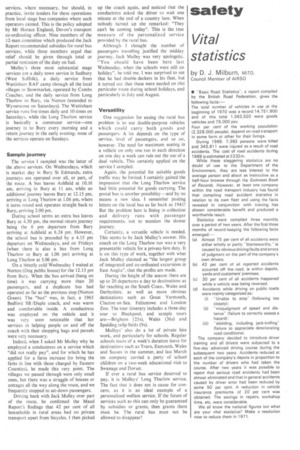safety Vital statistics
Page 43

If you've noticed an error in this article please click here to report it so we can fix it.
by D. J. Milburn, MITO Council Member of AIFISO
• 'Basic Road Statistics", a report compiled by the British Road Federation, gives the following facts:—
The total number of vehicles in use at the beginning of 1970 was a record 14,751.800 and of this total 1.563,520 were goods vehicles and 79,000 psv.
Four per cent of the working population (2,328,000 people), depend on road transport in some form or other for their livings.
During 1969, 7,383 persons were killed and 345,811 were injured as a result of road accidents. The cost of road accidents during 1969 is estimated at £232m.
While these staggering statistics are no doubt of use to the Department of the Environment, they are less interest to the average person and about as instructive as a half-hour browse through the Guinness Book of Records. However, at least one company within the road transport industry has found that compiling road accident statistics in relation to its own fleet and using the facts revealed in conjunction with training has shown considerable benefit and produced a worthwhile result.
Statistics were compiled three monthly over a period of two years. After the first three months of record-keeping the following facts emerged: (a) Almost 75 per cent of all accidents were either wholly or partly "blameworthy," ie caused by obvious driving faults and errors of judgment on the part of the company's own drivers.
(b) 43 per cent of all reported accidents occurred off the road, ie within depots, yards and customers' premises.
(c) 30 per cent of all accidents happened while a vehicle was being reversed.
(d) Accidents while driving on public roads were mainly categorized as:
(i) "Unable to stop" (following too closely): (ii) "misjudgment of speed and distance" (failure to correctly assess a hazard): (iii) "skidding, including jack-knifing" (failure to appreciate deteriorating road conditions).
The company decided to introduce driver training and all drivers were subjected to a five-day advanced driving course during the subsequent two years. Accidents reduced at each of the company's depots in proportion to the number of drivers who had taken the course. After two years it was possible to report that serious road accidents had been almost eliminated and that in general accidents caused by driver error had been reduced by some 50 per cent. A reduction in vehicle insurance premiums of 20 per cent was obtained. The savings in repairs, workshop time, etc, were considerable.
We all know the national figures but what are your vital statistics? Make a resolution now to reduce them in 1971.




































































































